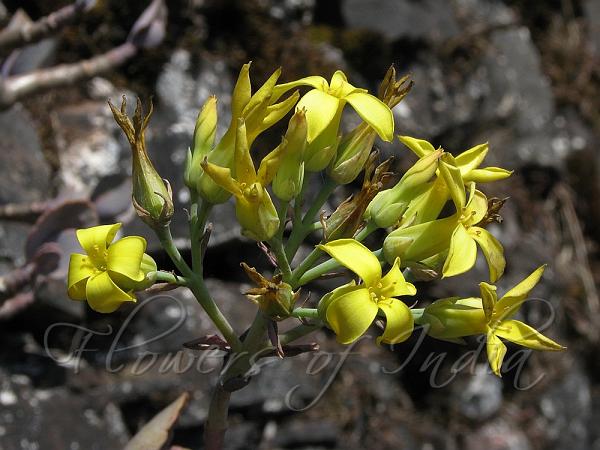|
| Never-Die |
|

|

| File size | 208372 |
| Original date | 1/25/14 1:31 PM |
| Resolution | 1000 x 750 |
| Flash | Flash did not fire, auto |
| Focal length | 17.7mm |
| Exposure time | 1/400s |
| Aperture | 4.0 |
| Focus Distance | |
| Metering Mode | Multi-segment |
| Camera make | Canon |
| Camera model | Canon PowerShot S5 IS |
| Sensor type | OneChipColorArea |
|
|
|
|
Photo: |
Botanical name: Kalanchoe integra Family: Crassulaceae (Sedum family)
Synonyms: Kalanchoe spathulata, Kalanchoe yunnanensis
Synonyms: Kalanchoe spathulata, Kalanchoe yunnanensis
Never-Die is a fleshy perennial plant which is
hairless or glandular-hairy distally. Stems are 1-7 ft long. Leaf
blades are obovate, 5-20 cm, margins shallowly and irregularly crenate,
tip blunt. Flowers are borne in cymes often lax, compound,
glandular-hairy. Flower-stalks are 0.5-2 cm long. Flowers are fragrant,
yellow or red-orange, flask-shaped (inflated on lower side), tube
1.5-1.6 cm, petals spreading, 8-10 mm. Sepals are ascending,
triangular-lanceolate, 4-10 mm. Never-Die is native to India, China,
Japan and many other countries.
Medicinal uses:  Never-Die is used in folklore medicine for hypertension and to prevent
and treat cerebrovascular disorders like stroke etc. Warmed leaf-sap is
a common treatment for ear-ache. In Ghanaian medicine the leaves are
deemed to have both purifying and mitigating properties. Boiled leaves
are used for asthma, and one leaf soaked in water when taken internally
for palpitations acts as a sedative. In Nigeria a leaf-infusion and
decoction is taken as a sedative, often in asthma. The whole plant in
decoction is administered as an anthelmintic enema; a root-decoction is
taken by women in pregnancy as a tonic, and the fresh root is used as a
snuff (or is chewed) to treat colds. In Ivory Coast the leaf-sap is
used as an antemetic and to calm intercostal and intestinal pain.
Leaves are put into cuts to staunch bleeding and are rubbed on feverish
infants, while a leaf-decoction is given to pregnant women by enema as
a tonic.
Never-Die is used in folklore medicine for hypertension and to prevent
and treat cerebrovascular disorders like stroke etc. Warmed leaf-sap is
a common treatment for ear-ache. In Ghanaian medicine the leaves are
deemed to have both purifying and mitigating properties. Boiled leaves
are used for asthma, and one leaf soaked in water when taken internally
for palpitations acts as a sedative. In Nigeria a leaf-infusion and
decoction is taken as a sedative, often in asthma. The whole plant in
decoction is administered as an anthelmintic enema; a root-decoction is
taken by women in pregnancy as a tonic, and the fresh root is used as a
snuff (or is chewed) to treat colds. In Ivory Coast the leaf-sap is
used as an antemetic and to calm intercostal and intestinal pain.
Leaves are put into cuts to staunch bleeding and are rubbed on feverish
infants, while a leaf-decoction is given to pregnant women by enema as
a tonic.
 Never-Die is used in folklore medicine for hypertension and to prevent
and treat cerebrovascular disorders like stroke etc. Warmed leaf-sap is
a common treatment for ear-ache. In Ghanaian medicine the leaves are
deemed to have both purifying and mitigating properties. Boiled leaves
are used for asthma, and one leaf soaked in water when taken internally
for palpitations acts as a sedative. In Nigeria a leaf-infusion and
decoction is taken as a sedative, often in asthma. The whole plant in
decoction is administered as an anthelmintic enema; a root-decoction is
taken by women in pregnancy as a tonic, and the fresh root is used as a
snuff (or is chewed) to treat colds. In Ivory Coast the leaf-sap is
used as an antemetic and to calm intercostal and intestinal pain.
Leaves are put into cuts to staunch bleeding and are rubbed on feverish
infants, while a leaf-decoction is given to pregnant women by enema as
a tonic.
Never-Die is used in folklore medicine for hypertension and to prevent
and treat cerebrovascular disorders like stroke etc. Warmed leaf-sap is
a common treatment for ear-ache. In Ghanaian medicine the leaves are
deemed to have both purifying and mitigating properties. Boiled leaves
are used for asthma, and one leaf soaked in water when taken internally
for palpitations acts as a sedative. In Nigeria a leaf-infusion and
decoction is taken as a sedative, often in asthma. The whole plant in
decoction is administered as an anthelmintic enema; a root-decoction is
taken by women in pregnancy as a tonic, and the fresh root is used as a
snuff (or is chewed) to treat colds. In Ivory Coast the leaf-sap is
used as an antemetic and to calm intercostal and intestinal pain.
Leaves are put into cuts to staunch bleeding and are rubbed on feverish
infants, while a leaf-decoction is given to pregnant women by enema as
a tonic. | Identification credit: Shrikant Ingalhalikar | Photographed at Mullayangiri Peak, Karnataka. |
• Is this flower misidentified? If yes,